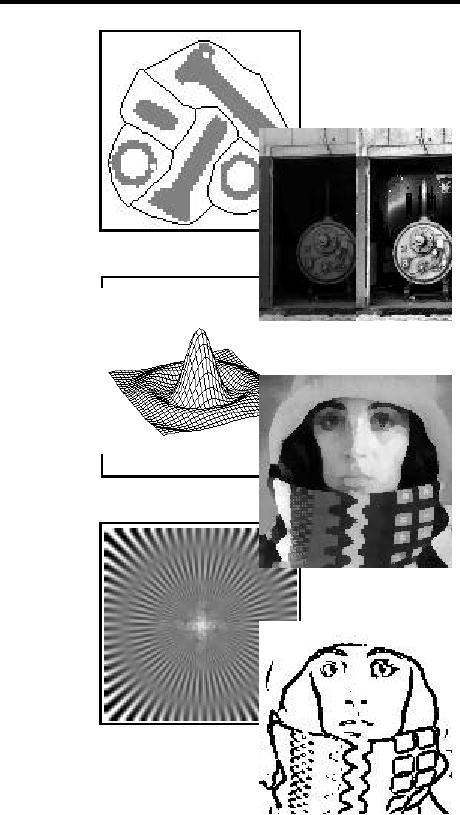 |
Introduction |
| Digital Image Definitions:COMMON VALUES, Types of operations, VIDEO PARAMETERS >> |

Fundamentals of Image
Processing
Ian T.
Young
Jan J.
Gerbrands
Lucas J. van
Vliet
CIP-DATA
KONINKLIJKE BIBLIOTHEEK, DEN
HAAG
Young,
Ian Theodore
Gerbrands,
Jan Jacob
Van
Vliet, Lucas Jozef
FUNDAMENTALS OF IMAGE PROCESSING
ISBN
9075691017
NUGI
841
Subject
headings: Digital Image
Processing / Digital Image
Analysis
All
rights reserved. No part of this
publication may be reproduced, stored in
a retrieval system, or
transmitted
in any form or by any means--electronic,
mechanical, photocopying, recording, or
otherwise--without
the prior written permission of
the authors.
Version
2.2
Copyright
© 1995, 1997, 1998 by I.T.
Young, J.J. Gerbrands and
L.J. van Vliet
Cover
design: I.T. Young
Printed
in The Netherlands at the Delft
University of Technology.

Fundamentals
of Image Processing
1.
Introduction..............................................1
2.
Digital
Image
Definitions.........................2
3.
Tools........................................................6
4.
Perception...............................................22
5.
Image
Sampling.....................................28
6.
Noise......................................................32
7.
Cameras.................................................35
8.
Displays.................................................44
9.
Algorithms.............................................44
Ian
T. Young
10.
Techniques.............................................85
Jan
J. Gerbrands
11.
Acknowledgments...............................108
Lucas
J. van Vliet
Delft
University of Technology
12.
References............................................108
1.
Introduction
Modern
digital technology has made
it possible to manipulate
multi-dimensional
signals
with systems that range
from simple digital circuits
to advanced parallel
computers.
The goal of this
manipulation can be divided
into three categories:
image
in →
image
out
·
Image Processing
image
in →
measurements
out
·
Image Analysis
image
in →
high-level
description out
·
Image Understanding
We
will focus on the fundamental
concepts of image
processing.
Space does not
permit
us to make more than a few
introductory remarks about
image
analysis.
Image
understanding requires an
approach that differs fundamentally
from the
theme
of this book. Further, we will
restrict ourselves to twodimensional
(2D)
image
processing although most of
the concepts and techniques that are to
be
described
can be extended easily to three or more
dimensions. Readers interested in
either
greater detail than presented here or in
other aspects of image processing
are
referred
to [1-10]
We
begin with certain basic
definitions. An image defined in
the "real world" is
considered
to be a function of two real
variables, for example,
a(x,y) with
a
as
the
amplitude
(e.g. brightness) of the
image at the real
coordinate
position (x,y). An
image
may be considered to contain sub-images sometimes
referred to as
Table of Contents:
- Introduction
- Digital Image Definitions:COMMON VALUES, Types of operations, VIDEO PARAMETERS
- Tools:CONVOLUTION, FOURIER TRANSFORMS, Circularly symmetric signals
- Perception:BRIGHTNESS SENSITIVITY, Wavelength sensitivity, OPTICAL ILLUSIONS
- Image Sampling:Sampling aperture, Sampling for area measurements
- Noise:PHOTON NOISE, THERMAL NOISE, KTC NOISE, QUANTIZATION NOISE
- Cameras:LINEARITY, Absolute sensitivity, Relative sensitivity, PIXEL FORM
- Displays:REFRESH RATE, INTERLACING, RESOLUTION
- Algorithms:HISTOGRAM-BASED OPERATIONS, Equalization, Binary operations, Second Derivatives
- Techniques:SHADING CORRECTION, Estimate of shading, Unsharp masking
- Acknowledgments
- References